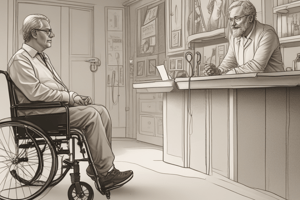Podcast
Questions and Answers
The Social Model of disability attributes disability to an individual's body being broken.
The Social Model of disability attributes disability to an individual's body being broken.
False (B)
What is the main focus of the Medical Model of disability?
What is the main focus of the Medical Model of disability?
- Opportunities for personal growth
- Structures of society as the problem
- Impairment as the problem (correct)
- Functional limitations due to disability
What does the Biopsychosocial Model of disability integrate?
What does the Biopsychosocial Model of disability integrate?
medical and social models
The Charity Model regards people with disabilities as _ _ _ _ _ _ _ _ _ _ _ _ _ _ _ _ _ _ and in need of assistance from the outside.
The Charity Model regards people with disabilities as _ _ _ _ _ _ _ _ _ _ _ _ _ _ _ _ _ _ and in need of assistance from the outside.
Flashcards are hidden until you start studying
Study Notes
Models of Disability
- Medical Model: views impairment as the problem, emphasizing the individual's bodily imperfections.
- Social Model: views societal structures as the problem, highlighting the complexities of environmental conditions.
- Biopsychosocial Model: integrates medical and social models, considering biological, individual, social, and environmental perspectives.
- Economic Model: defines disability by a person's inability to participate in work, assessing productivity and economic consequences.
- Functional Solutions Model: identifies functional limitations to create and promote solutions.
- Social Identity or Cultural Affiliation Model: refers to deriving one's personal identity from a group membership, especially among deaf people.
- Charity Model: regards people with disabilities as unfortunate and in need of assistance.
Categories and Characteristics of Disabilities and Associated Barriers
Visual Disabilities
- Blindness
- Color blindness
- Low vision
Auditory Disabilities
- Deafness
- Hard of hearing
- Central auditory processing disorder
Deafblindness
Speech Disabilities
- Articulation
- Aphasia
- No speech
Mobility, Flexibility, and Body Structure Disabilities
- Manual dexterity / fine motor control
- Ambulation
- Muscle fatigue
- Body size or shape
Cognitive Disabilities
- Intellectual
- Dyslexia
- Dysgraphia
- Math and computation
- Attention Deficit Hyperactivity Disorder
- Autism Spectrum Disorder
- Non-verbal Learning Disability
Seizure Disabilities
- General seizure disorders
- Photosensitive epilepsy
Psychological / Psychiatric Disabilities
- Social
- Emotional
- Behavioral
Multiple / Compound Disabilities
Assistive Technologies
Visual Disabilities
- Blindness and Low Vision
- Physical World: white cane, service animals, braille, large print, tactile markers, navigation apps
- Digital: screen readers, screen magnifiers, refreshable braille displays, audio description
- Colorblindness
- Physical World: glasses, visual filters
- Digital: color contrast adjusting software
Auditory Disabilities
- Deafness and Hard of Hearing
- Physical World: visual labels, haptic and visual alerts, sign language interpretation, real-time captioning (CART), hearing aids
- Digital: captions, audio transcripts, video conferencing for signing or CART
- Auditory Processing Disorder
- Physical World: room acoustics, graphical organizers, note-taking apps
- Digital: captions, speech-to-text
Deaf-blindness
- Physical World: white cane, service animal, navigation aids, printed braille
- Digital: screen readers with output to braille, refreshable braille displays, haptic alerts/feedback
Speech Disabilities
- Physical world: text-to-speech software, word prediction software
- Digital: articulation aids, AAC devices, text-based alternatives to speech
Mobility and Dexterity Disabilities
- Physical World: canes, walkers, wheelchairs, prosthetics
- Digital: adaptive keyboards, oversize mice or trackballs, adjustable monitors
Cognitive Disabilities
- Intellectual Disabilities
- Physical World: simplified environment, AAC, visual/audio alternatives to text
- Digital: simplified content and interfaces, word prediction software
- Reading and Dyslexia
- Physical World: picture dictionaries, highlighters
- Digital: smart pens, screen readers, text-to-speech
- Math and Computation
- Physical World: graph paper, manipulatives, calculators
- Digital: text-to-speech, data provided in a data table or accompanied by a text description
Psychiatric / Psychological Disabilities
- Physical World: positive reinforcement, guided meditation, noise monitoring devices
- Digital: apps for mood, stress, and anxiety management
Disability Statistics and Demographics
Global Statistics
- 15% of the world's population lives with some form of disability
- 2-4% experience significant difficulties in functioning
- 1.25 billion people have some form of disability
The Cycle of Poverty
- 20% of the world's poorest people have some kind of disability
- Preventable, curable diseases are a major cause of disability
Global Visual Disability
- 285 million people are visually impaired
- 90% of visually impaired population live in developing countries
- 80% of visual impairments are curable
- Cataract, glaucoma, and age-related macular degeneration are leading causes
Aging and Disability
- As people age, so does their chance of acquiring a disability
- Age-related changes affect vision, hearing, muscular strength, bone strength, immunity, and nerve function
- In countries with life expectancies over 70 years, people spend an average of 8 years living with disabilities
U.S. Disability Statistics
- In 2016, the overall prevalence rate of people with a disability of all ages in the US was 12.6%
- 39 million of the 317 million individuals of all ages in the US reported one or more disabilities
Etiquette
People-first Language
- Avoid defining someone by their bodily attributes; instead, use people-first language to promote respect and inclusivity.
Studying That Suits You
Use AI to generate personalized quizzes and flashcards to suit your learning preferences.




